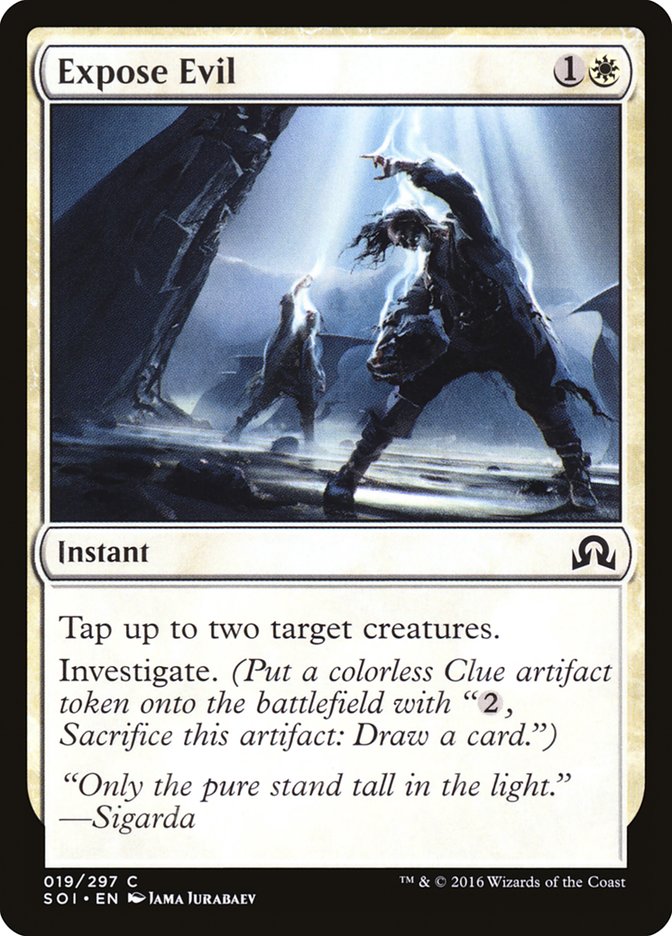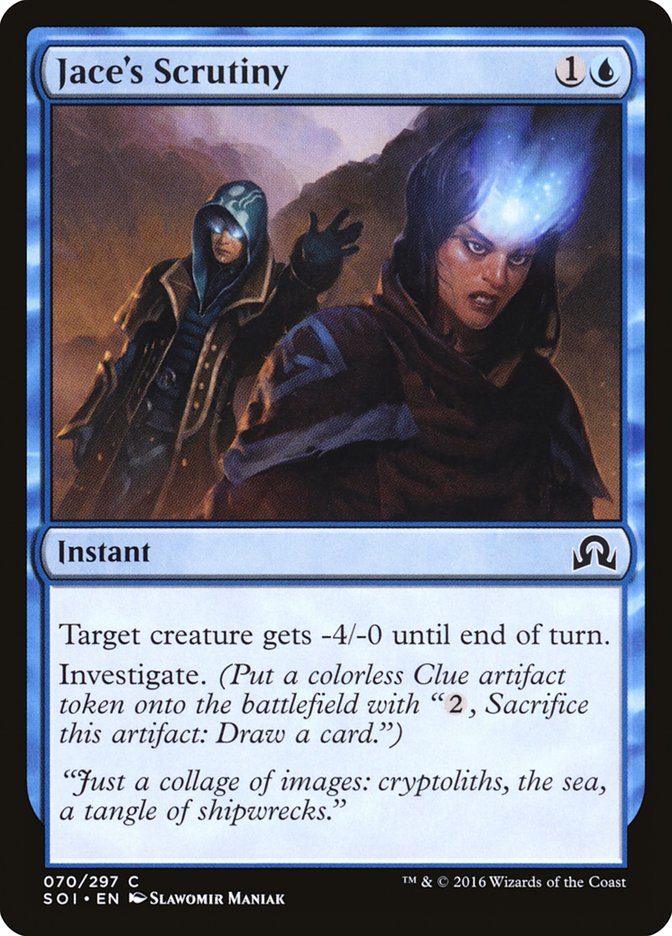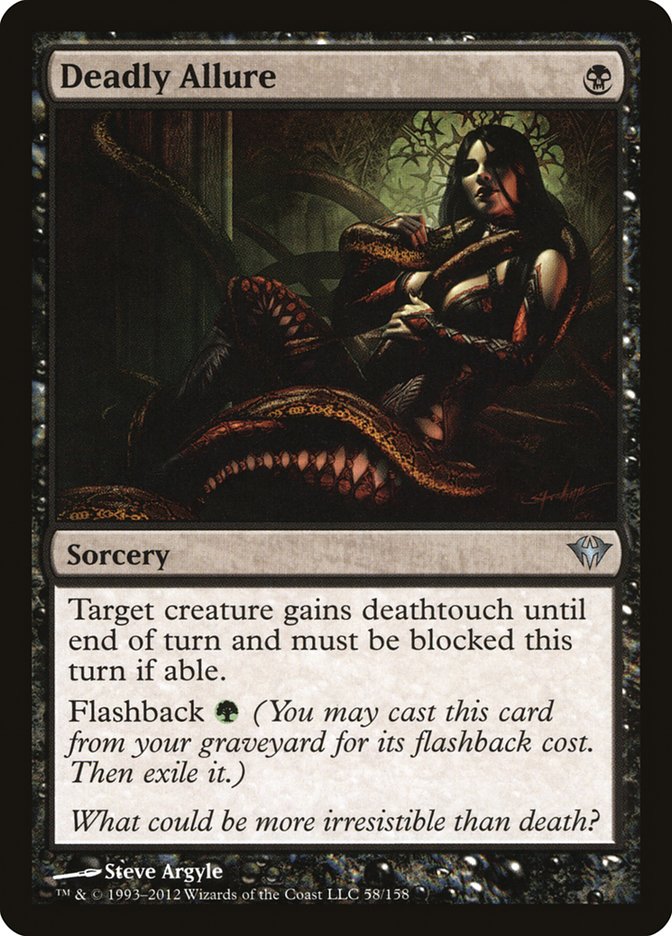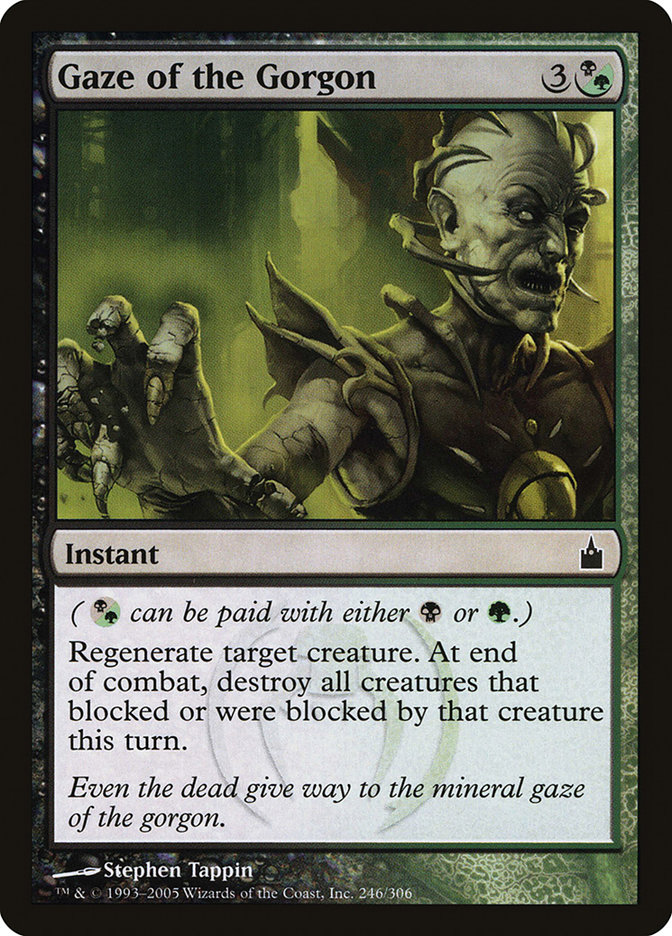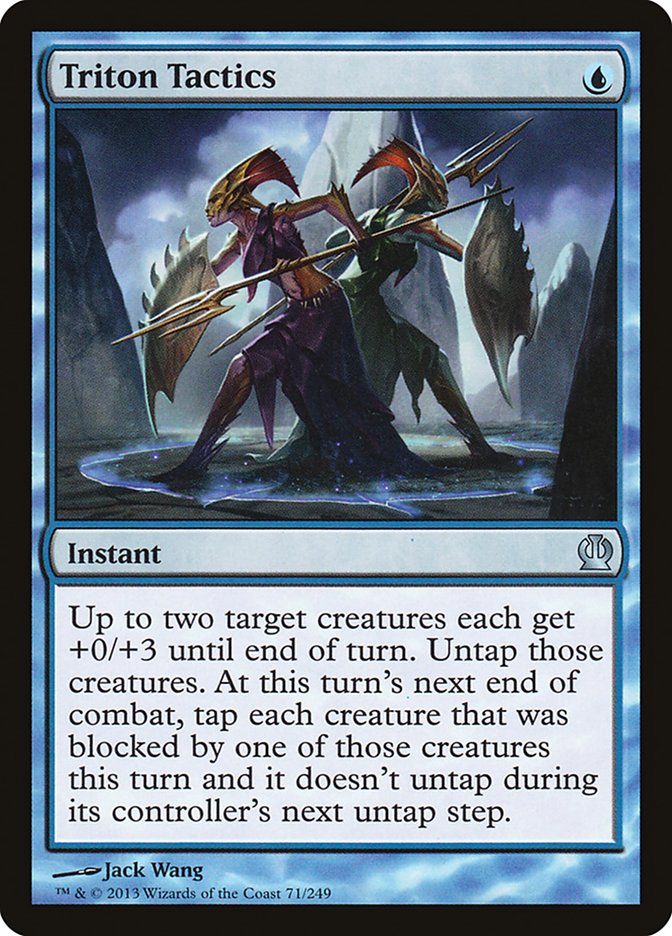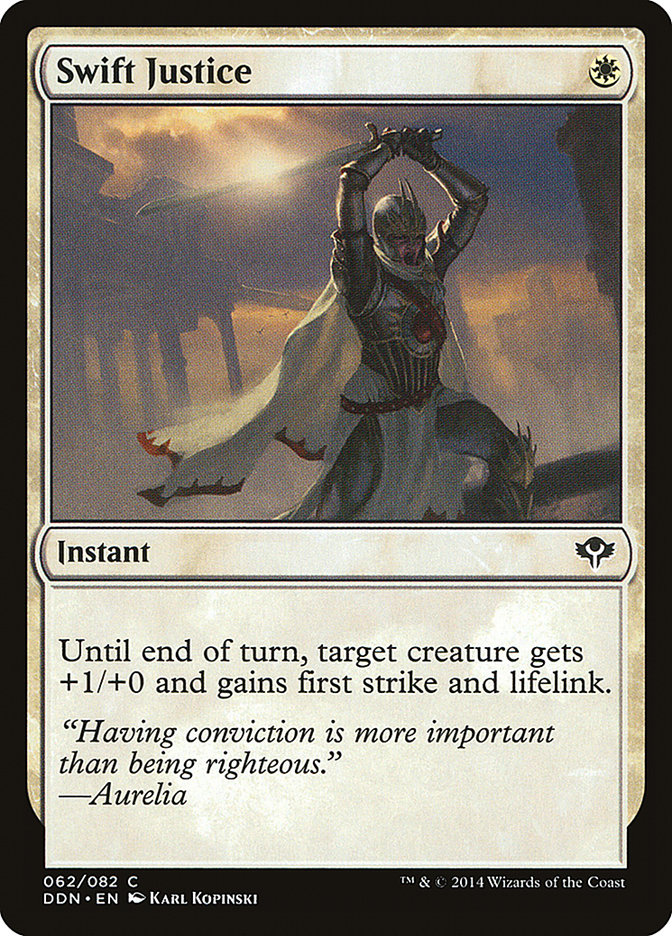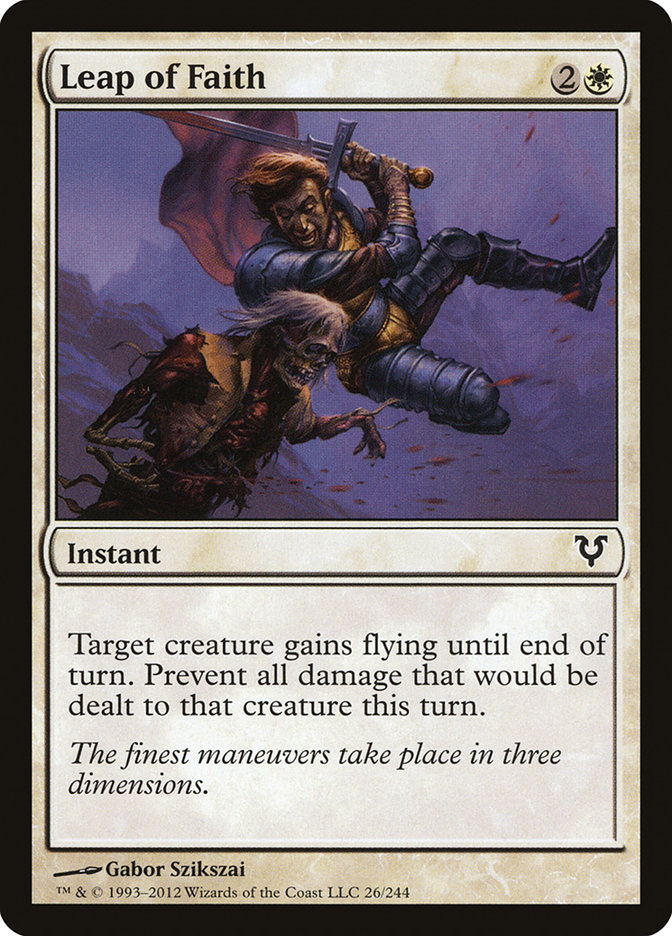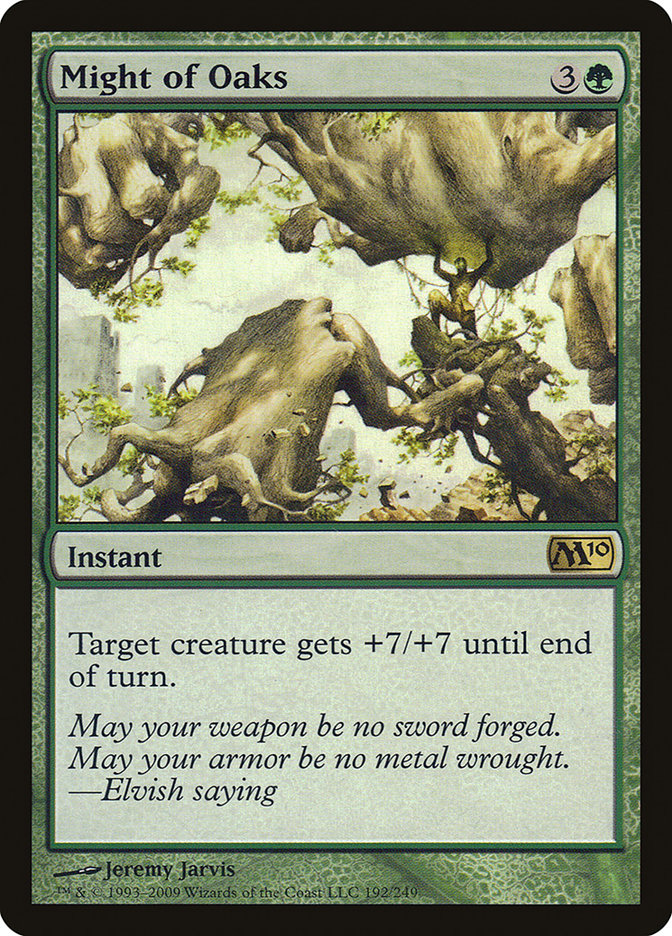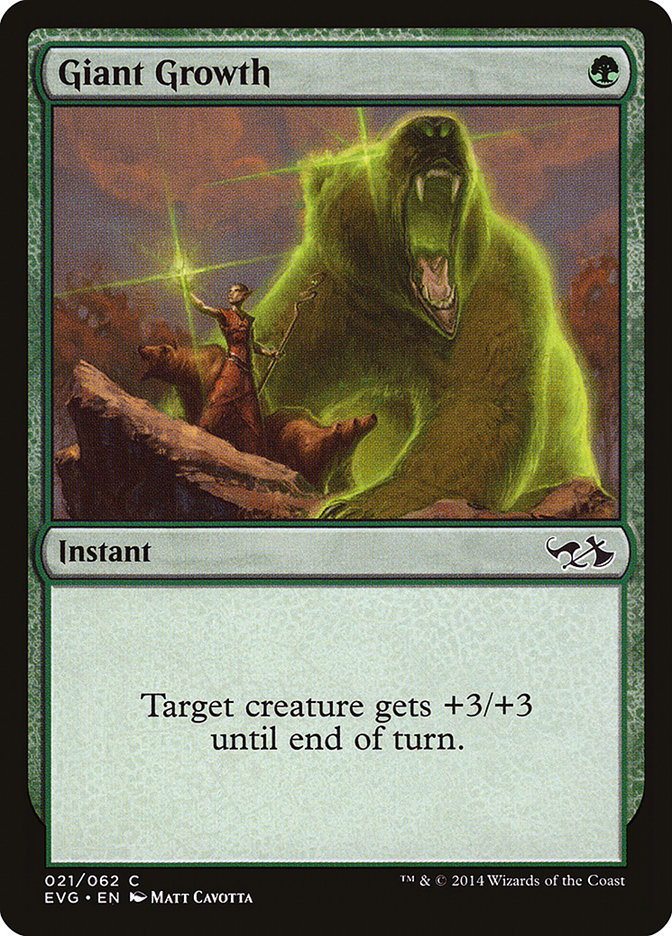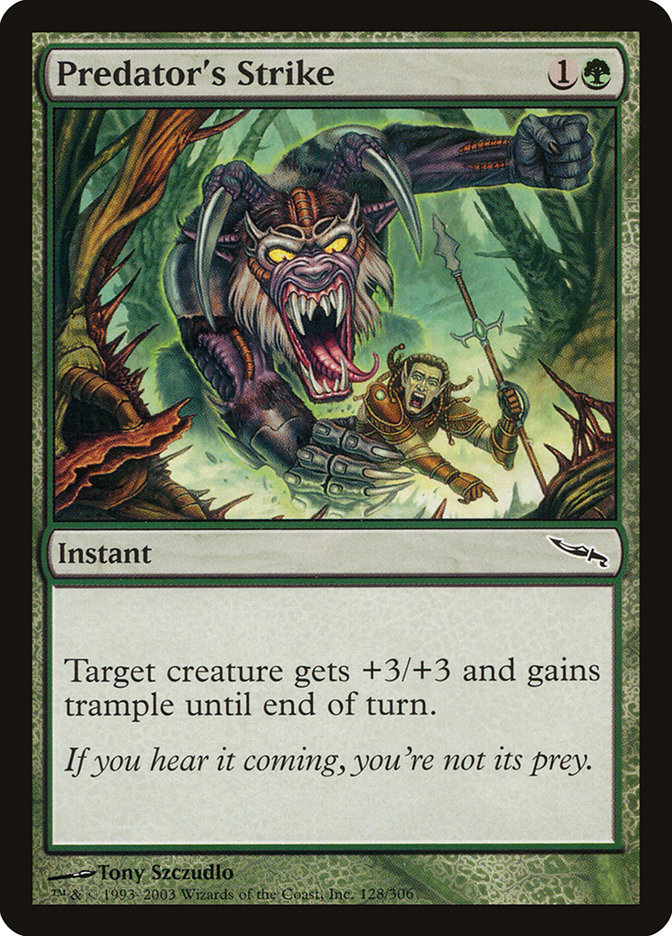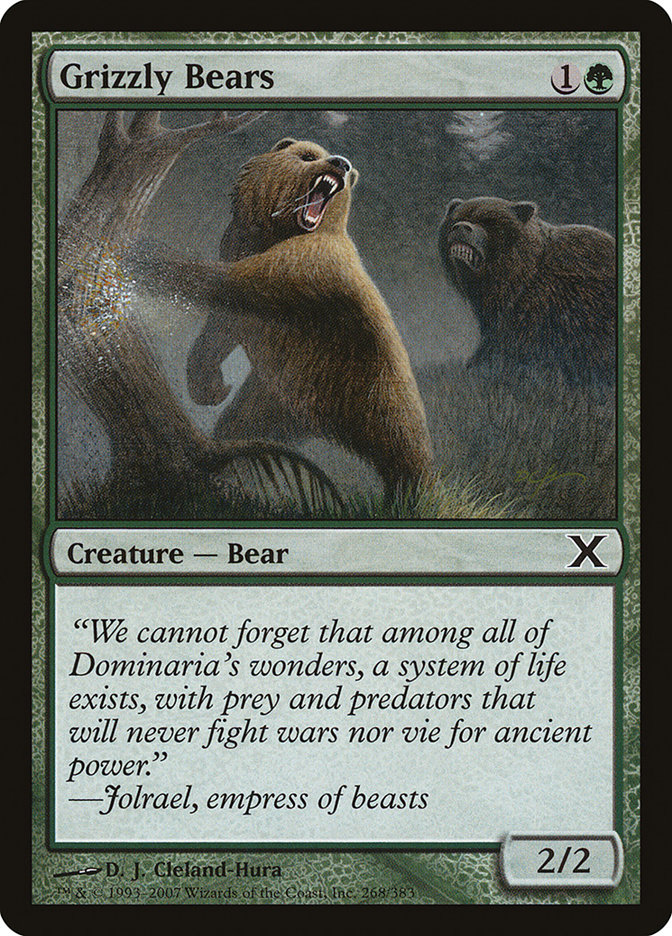What he said was that, because the format has a lot of creatures with high toughness relative to their power, blocking is good, and combat tricks are worse. I argued that the opposite is true, that because creatures have higher toughness, combat tricks are better than they would otherwise be.
I stand by my position here, but his point isn’t exactly wrong; it was just missing a step. Regardless, I think unpacking both positions, as well as discussing evaluations and uses of combat tricks in Limited, is a worthwhile topic. This is especially true for players who mostly know Constructed, as combat tricks are rare there (and mostly used for combo kills), so it can be easy to not build a lot of experience evaluating the nuances of building with, playing with, and evaluating tricks from a Constructed perspective.
At the most basic level, a combat trick is something of a split card that can function as a removal spell or a protection spell (or direct damage spell, I suppose). You’ll usually get a good rate (they don’t tend to cost much mana), but the situations where you can use it to do what you want are somewhat more rare or require some work to engineer.
Combat tricks are generally better in aggressive decks than controlling decks because aggressive decks tend to have cheaper creatures, which are smaller, which attack into larger creatures. When the opponent blocks, the trick allows you to kill the larger creature for much less mana than the larger creature cost (ideally while also pushing damage because other creatures were able to get through unblocked, as having the trick allowed you to attack with all of your creatures).
The larger you creatures are, the less they need tricks to win in combat. Also, it’s much better to play a trick on your turn than on your opponent’s turn. In order to use a trick on your opponent’s turn, you must leave mana unspent to have the option, and then if they don’t play into it, you may not get the opportunity to profitably spend the mana. Also, if you use a trick on your opponent’s turn, it’s very likely that their mana will be untapped, which means they’ll be able to cast any tricks or removal spells of their own, which makes trying to use your trick much more of a gamble.
This is the heart of Ben’s argument. If blocking is good, combat tricks are bad. That sentence isn’t accurate; if blocking is good, combat tricks are good, because the scenario where you want to use them will come up more. What Ben really meant was, “If blocking is good enough that you want to plan to block rather than attack, combat tricks are bad.”
Combat tricks will generally perform best in aggressive decks, and if all the aggressive decks are bad, combat tricks will also be bad. However, if blocking is good, combat tricks will be the best way to draft an aggressive deck that can beat a deck that is trying to block, which was the heart of my argument.
I would unpack this evaluation a little differently. The more good removal there is, the worse combat tricks are, and the more decks there are that don’t rely on combat, the worse combat tricks are. In Shadows over Innistrad, the fact that your opponent might be playing a U/R Rise from the Tides deck makes combat tricks less likely, as there will be some matches where you’ll have trouble finding a profitable spot to use one. This, analogously, is why combat tricks aren’t played in Constructed. Too many decks don’t rely on creature combat or perhaps don’t play creatures at all. Removal, especially efficient, instant-speed removal, is far more common.
If control decks are good, they usually won’t want tricks, which means aggressive decks can get them easily. If control decks are so good that aggressive decks are bad, tricks will usually be pretty bad, but most tricks are actually best when aggressive decks and control decks that play larger creatures and try to block are both good. If only aggressive decks are good, tricks aren’t generally that great, because you’re never getting the highest payoff, killing a large blocker.
Details matter, and not all tricks are created the same.
First, not all tricks just increase power and toughness, and different keywords are clearly differently suited to different strategies.
Deathtouch is at its best in a deck that’s trying to block with small creatures. Large creatures don’t need deathtouch, and giving it to an attacker isn’t great because you’ll usually lose your creature, which isn’t productive, and a trick that gives deathtouch isn’t going to give much power, so it won’t be effective as a “burn” spell to end the game. Tricks that give deathtouch are basically “tempo” cards for control decks; they let you play two spells a turn and kill an attacker. They also work well on defense because they’re good “counter-tricks.” If your opponent plays a trick and you answer with this, you negate their edge at worst and maybe also save your creature, depending on the card.
Regeneration, protection, and indestructibility are best in decks with large creatures, unlike most tricks. This is fairly simple: the larger investment you make in a single creature, the most valuable it is to protect it. This is even more important in decks with Auras, as the investment is even larger.
Tricks that untap a creature are interesting to place. Such spells are best cast on your opponent’s turn to create a surprise blocker. This means the trick will be used defensively, but you’re only getting to do that if your creature is already tapped, which means you probably needed to be attacking. These tricks are best in aggressive decks against other aggressive decks, especially if your aggressive deck has evasive creatures, as you had to be able to attack without telegraphing the trick and then have them attack into it after leaving it up for the maximum benefit.
First strike is best on offense because it’s generally extremely vulnerable to a counter-trick, which means you really want to play it when the opponent is tapped out. Also, if you’re aggressive, it’s more likely you have creatures with high power and low toughness, where first strike is best.
Flying is tricky; while granting reach (as in the mechanic) is obviously best in a control deck, granting the other kind of reach (as in the ability to kill an opponent who has established control of the battlefield) is best in an aggressive deck. In both cases, evaluating this is going to depend on the needs of your deck, and obviously, in both cases, it will be best when your creatures don’t already have flying, not only because it’s redundant on a creature that already has it but because you’ll have less need for it in a single instant.
Sizing of pump spells also matters and needs to be evaluated in the context of a set specifically. As a simplified example, if most of the good common two-drops are 2/1 and the good three drops are 3/2, an instant that gives a creature +1/+1 will be very weak; its only effect among those creatures will to be save the three-mana creature from the two mana creature. If, on the other hand, good two-drops are 2/2 and good three-drops are 2/3, a trick that gives +1/+1 will be relatively strong, allowing any creature to kill another other creature and live.
This principle is why, in general, power/toughness tricks are better in formats that have more toughness than power and worse in formats that have more power than toughness; clearly, the reverse is true of tricks that grant first strike or protection.
Also, the more similar creatures are in size, the better pump spells that only give small bonuses are. In a set with Eldrazi, where one player is likely to have 2/2s and the other 8/8s, Giant Growth is a horrible card. In a set where the biggest creatures you can find are around 4/4, like the original Mirrodin, Giant Growth is at its best (and, in fact, I think Predator’s Strike is the best green common in that set, while it wouldn’t be in most sets).
It’s good to develop a sense of how good pump spells generally are in a format, but honestly, it’s not that important how good they are in general. Because they’re very rarely extremely early picks, you’ll almost always be evaluating them in the context of a deck whose needs and creatures you know something about.
Where I think most players are giving up the most value is in sideboarding with combat tricks. Sideboarding is generally not a topic that gets enough attention, and Limited doesn’t get much attention these days. When people do talk about sideboarding, it’s usually a sideboarding guide for Constructed, and when they talk about Limited, it’s usually card evaluation. Combat tricks are among the most common and important cards to sideboard in or out.
First, consider siding out any combat trick your opponent has seen. This doesn’t mean you should always cut them, because how they’re positioned in the matchup is definitely more important than “have they seen it?”, but you’ll get some value from their knowledge of it without having it in your deck, as they’ll play around it, and it’ll be harder to use well for the same reason.
More importantly, after playing a game, you’ll have a lot more information about creature sizing. Rather than trying to know the set well enough to find generalities about how big creatures are relative to each other, you can write down the size of all the creatures your opponent plays, look at the size of all the creatures in your deck, and then look at how often a particular combat trick will make one of your smaller creatures beat one of their larger creatures. You might realize that your aggressive white deck full of 2/2s doesn’t want a +2/+2 trick against a green deck with mana creatures and 6/5s but that the same trick great against a U/B defensive deck with a lot of 3/3s and 2/4s.
Obviously, don’t just consider combat tricks in your maindeck; also consider how any in your sideboard would impact likely combat steps, and don’t just consider combat. If your opponent has a lot of removal spells that care about the size of your creatures, think about how effective your tricks would be at saving them and how likely the game is to play out in a way where you can have mana to cast them at the right time. If your opponent has Lightning Strike, Giant Growth might not actually be good at saving your Hill Giant because they’ll just kill it on turn 4, but if they have Burn Trail, it will be good at protecting your Grizzly Bears because you’ll have untapped before they have enough mana to cast it. (Why you care about protecting your Grizzly Bears is a separate, and relevant, question.)
Also, there are certain spots where tricks can change value relative to their expectations in other ways. For example, if you have a large creature and you know your opponent’s only way to deal with it is to block it with multiple creatures, a trick that saves it will be outstanding, even though tricks are generally not good with large creatures (as blocking with several creatures isn’t generally the most common way to deal with them).
Clearly, this is about fundamentals, ideas that can be applied to any Limited format. I hope this has improved your ability to ask the right questions and consider the right issues when evaluating inclusion of combat tricks in Limited. As Wizards of the Coast has been finding ways to spread them throughout all the colors at common, and various ways to push their power level, this skill is becoming even more important.



